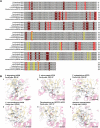Melanin biopolymer synthesis using a new melanogenic strain of Flavobacterium kingsejongi and a recombinant strain of Escherichia coli expressing 4-hydroxyphenylpyruvate dioxygenase from F. kingsejongi
- PMID: 35501871
- PMCID: PMC9063278
- DOI: 10.1186/s12934-022-01800-w
Melanin biopolymer synthesis using a new melanogenic strain of Flavobacterium kingsejongi and a recombinant strain of Escherichia coli expressing 4-hydroxyphenylpyruvate dioxygenase from F. kingsejongi
Abstract
Background: Melanins are a heterologous group of biopolymeric pigments synthesized by diverse prokaryotes and eukaryotes and are widely utilized as bioactive materials and functional polymers in the biotechnology industry. Here, we report the high-level melanin production using a new melanogenic Flavobacterium kingsejongi strain and a recombinant Escherichia coli overexpressing F. kingsejongi 4-hydroxyphenylpyruvate dioxygenase (HPPD).
Results: Melanin synthesis of F. kingsejongi strain was confirmed via melanin synthesis inhibition test, melanin solubility test, genome analysis, and structural analysis of purified melanin from both wild-type F. kingsejongi and recombinant E. coli expressing F. kingsejongi HPPD. The activity of F. kingsejongi HPPD was demonstrated via in vitro assays with 6 × His-tagged and native forms of HPPD. The specific activity of F. kingsejongi HPPD was 1.2 ± 0.03 μmol homogentisate/min/mg-protein. Bioreactor fermentation of F. kingsejongi produced a large amount of melanin with a titer of 6.07 ± 0.32 g/L, a conversion yield of 60% (0.6 ± 0.03 g melanin per gram tyrosine), and a productivity of 0.03 g/L·h, indicating its potential for industrial melanin production. Additionally, bioreactor fermentation of recombinant E. coli expressing F. kingsejongi HPPD produced melanin at a titer of 3.76 ± 0.30 g/L, a conversion yield of 38% (0.38 ± 0.03 g melanin per gram tyrosine), and a productivity of 0.04 g/L·h.
Conclusions: Both strains showed sufficiently high fermentation capability to indicate their potential as platform strains for large-scale bacterial melanin production. Furthermore, F. kingsejongi strain could serve as a model to elucidate the regulation of melanin biosynthesis pathway and its networks with other cellular pathways, and to understand the cellular responses of melanin-producing bacteria to environmental changes, including nutrient starvation and other stresses.
Keywords: 4-Hydroxyphenylpyruvate dioxygenase; Flavobacterium kingsejongi; Melanin.
© 2022. The Author(s).
Conflict of interest statement
The authors declare that they have no known competing financial interests or personal relationships that could have appeared to influence the work reported in this paper.
Figures







Similar articles
-
Pyomelanin production via heterologous expression of 4-hydroxyphenylpyruvate dioxygenase (HPPD) and construction of HPPD inhibitor screening model.J Biosci Bioeng. 2023 Feb;135(2):93-101. doi: 10.1016/j.jbiosc.2022.10.005. Epub 2022 Dec 2. J Biosci Bioeng. 2023. PMID: 36470730
-
Isolation of pyomelanin from bacteria and evidences showing its synthesis by 4-hydroxyphenylpyruvate dioxygenase enzyme encoded by hppD gene.Int J Biol Macromol. 2018 Nov;119:864-873. doi: 10.1016/j.ijbiomac.2018.08.003. Epub 2018 Aug 3. Int J Biol Macromol. 2018. PMID: 30081124
-
4-Hydroxyphenylpyruvate Dioxygenase Thermolability Is Responsible for Temperature-Dependent Melanogenesis in Aeromonas salmonicida subsp. salmonicida.Appl Environ Microbiol. 2018 Dec 13;85(1):e01926-18. doi: 10.1128/AEM.01926-18. Print 2019 Jan 1. Appl Environ Microbiol. 2018. PMID: 30341077 Free PMC article.
-
4-Hydroxyphenylpyruvate dioxygenase.Arch Biochem Biophys. 2005 Jan 1;433(1):117-28. doi: 10.1016/j.abb.2004.08.015. Arch Biochem Biophys. 2005. PMID: 15581571 Review.
-
p-Hydroxyphenylpyruvate dioxygenase inhibitor-resistant plants.Pest Manag Sci. 2005 Mar;61(3):269-76. doi: 10.1002/ps.997. Pest Manag Sci. 2005. PMID: 15633191 Review.
Cited by
-
Biosynthesis of melanin from lignin hydrolysates by metabolically engineered Cupriavidus necator.Sci China Life Sci. 2025 Aug 19. doi: 10.1007/s11427-024-2864-5. Online ahead of print. Sci China Life Sci. 2025. PMID: 40844742
-
A comparative study using response surface methodology and artificial neural network towards optimized production of melanin by Aureobasidium pullulans AKW.Sci Rep. 2023 Aug 19;13(1):13545. doi: 10.1038/s41598-023-40549-z. Sci Rep. 2023. PMID: 37598271 Free PMC article.
-
Physiological Roles of Eumelanin- and Melanogenesis-Associated Diseases: A Look at the Potentialities of Engineered and Microbial Eumelanin in Clinical Practice.Bioengineering (Basel). 2024 Jul 25;11(8):756. doi: 10.3390/bioengineering11080756. Bioengineering (Basel). 2024. PMID: 39199714 Free PMC article. Review.
-
In Vitro and In Vivo Biocompatibility of Natural and Synthetic Pseudomonas aeruginosa Pyomelanin for Potential Biomedical Applications.Int J Mol Sci. 2023 Apr 25;24(9):7846. doi: 10.3390/ijms24097846. Int J Mol Sci. 2023. PMID: 37175552 Free PMC article.
-
Natural pigments derived from plants and microorganisms: classification, biosynthesis, and applications.Plant Biotechnol J. 2025 Feb;23(2):592-614. doi: 10.1111/pbi.14522. Epub 2024 Dec 6. Plant Biotechnol J. 2025. PMID: 39642082 Free PMC article. Review.
References
MeSH terms
Substances
Supplementary concepts
Grants and funding
LinkOut - more resources
Full Text Sources

